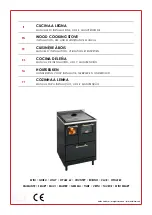
Page 16 |
DURANGO™
Vogelzang International Corp.
TR008 | 20110503.1
gases going up a cold chimney will cool rapidly.
Warm the chimney by allowing a hot fire to burn for
the first fifteen to thirty minutes after starting the fire.
Be careful not to over fire the stove. If any part of
the stove or chimney starts to glow, you are over
firing the stove. Masonry chimneys will take longer
to warm than manufactured chimneys on account of
their greater structural mass. Chimneys that have a
flue diameter larger than the stove outlet take more
heat to warm, thus resulting in a faster cooling of
the hot gases needed to build or maintain draft.
4. Chimney Installation and Maintenance
Confirm that
all
four minimum chimney height
requirements
listed in the
Chimney Connections
section of the manual have been met. The physics
that link chimney height with draft creation are vital
to the proper operation of the stove. Failure to meet
each of these minimum requirements will have an
adverse affect on draft. Avoid long horizontal runs
or multiple elbows. Use stove cement to seal joints
in the connector pipe section. Regularly clean the
chimney, connector pipe, rain cap, and spark ar-
restor screen. Creosote build up can reduce the
chimney draw and possibly create a chimney fire.
5. Temporarily out of Operation
After the fire has burned out, open the air control
to its fully open position. This will allow warm room
air to enter the chimney and keep it as warm as
possible until the stove is used again.
For assistance involving chimney draft issues, con-
tact a knowledgeable licensed heating and cooling
contractor in your area. For questions regarding
manufactured chimney, contact the manufacturer
of the chimney.
NOTE: A DRAFT READINg OF 0.05 TO 0.06 w.C.
(wATER COLUMN) IS REqUIRED FOR PROPER
BURNINg OF ThIS STOvE.
gLASS CARE
The following usage and safety tips should be
observed:
1. Inspect the glass regularly for cracks and breaks.
If you detect a crack or break, extinguish the fire
immediately and contact the manufacturer for a
replacement.
2. Do not slam the door or otherwise impact the glass.
When closing doors, make sure that logs or other
objects do not protrude to impact the glass.
3. Do not build fires against (or that might fall against)
the glass.
sERVicE HiNts continued...
4. Do not clean the glass with materials that may
scratch (or otherwise damage) the glass. Scratches
on the glass can develop into cracks or breaks dur-
ing operation.
5. Never attempt to clean the glass while the unit is
hot. If deposits are not very heavy, normal glass
cleaners are adequate using a soft, non-abrasive
cleaning pad. Heavier deposits may be removed
with oven cleaners.
6. Never put substances which can ignite explosively
in the unit. Even small explosions in confined areas
can blow out the glass.
gLASS REPLACEMENT
CAUTION: REPLACE gLASS ONLY wITh 5MM
hIgh TEMPERATURE CERAMIC gLASS OF ThE
PROPER SIzE. DO NOT USE TEMPERED gLASS
OR DOUBLE ThICkNESS wINDOw gLASS!
Gasket and Glass cleaning products are available
at local retail home centers. Manufacturers of cleaning
products include, A.W. Perkins Co. (www.awperkins.
com) or Rutland Products (www.rutland.com).
After extensive use, the gasket material which
provides glass and door seal may lose it’s resiliency
and will need to be replaced. Inspect glass and door
gaskets periodically to ensure proper seal; if gaskets
become frayed or worn, replace immediately.
gLASS REPLACEMENT PROCEDURE:
1. Ensure appliance is not in operation and is thor-
oughly cooled.
2. Remove screw and glass clip. (See parts list and
diagram.)
3. Lift glass out from glass clip.
4. Remove old gasket and clean glass.
5. Replace new gasket starting at the bottom of glass
working along edges, being sure to center gasket
channel on glass.
6. Trim to length and butt ends together.
7. Replace glass into door, being sure not to over-
tighten screw and clip.
DOOR gASkET REPLACEMENT
PROCEDURE:
1. Ensure appliance is not in operation and is thor-
oughly cooled.
continued on next page










































